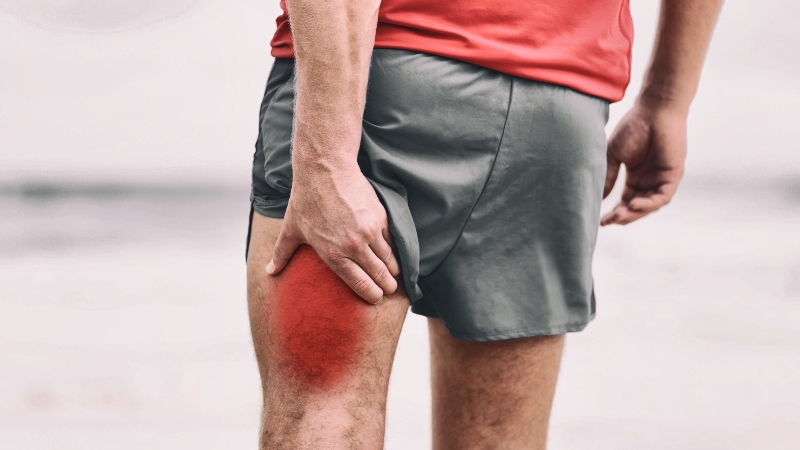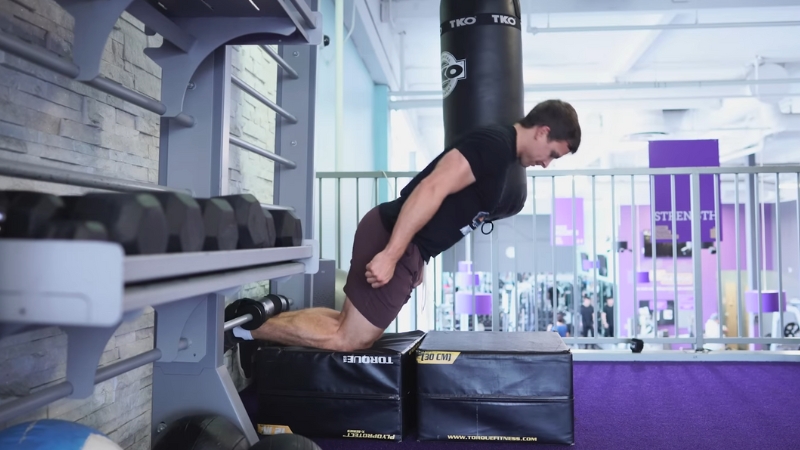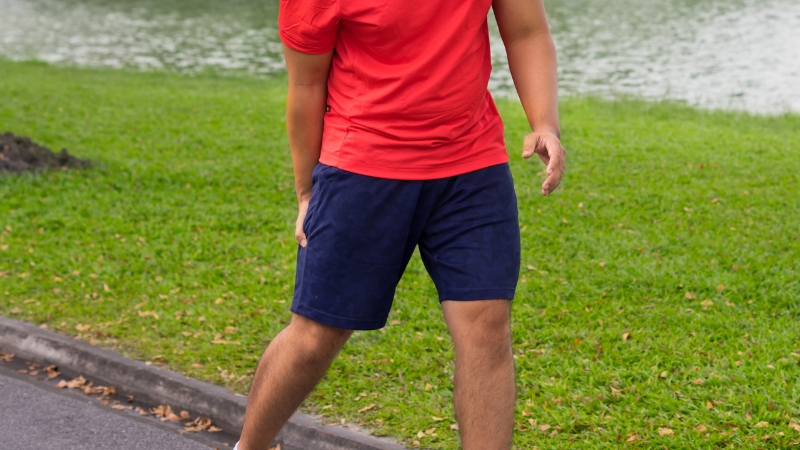The sudden jolt, the sharp pain in the back of your thigh – it’s a runner’s nightmare: a hamstring injury. This common setback can quickly sideline your training, leaving you frustrated and eager to get back on track.
The good news is that with a structured and patient approach to hamstring rehab, you can not only recover but also emerge stronger, more resilient, and better equipped to prevent future injuries.
This article will guide you through the essential phases of strength, mobility, and rebuilding, providing a clear roadmap for your journey back to pain-free running.
Table of Contents
ToggleHamstring Injuries in Runners

Your hamstrings are a powerful group of three muscles (biceps femoris, semitendinosus, and semimembranosus) that run down the back of your thigh. They are crucial for hip extension (propelling you forward) and knee flexion (bending your knee), both fundamental actions in running.
Hamstring injuries, often referred to as strains, occur when these muscles are stretched beyond their normal capacity, leading to tears in the muscle fibers.
For runners, this frequently occurs during the push-off phase or when reaching forward during the swing phase of the stride, particularly during sprints or sudden speed changes.
Several factors contribute to these injuries, including muscle imbalances, inadequate warm-ups, poor running mechanics, and overtraining. The critical first step in recovering from a runner’s hamstring injury is recognizing the injury and stopping activity immediately to prevent further damage.
Ignoring the pain often leads to a more severe and prolonged rehabilitation process.
Diagnosis and Acute Management
As soon as you suspect a hamstring injury, apply the RICE protocol: Rest, Ice, Compression, and Elevation. Resting the injured leg is paramount to allow initial healing. Apply ice packs for 15-20 minutes every 2-3 hours to reduce swelling and pain.
Gentle compression with a bandage can help minimize swelling, and elevating your leg above your heart can further reduce fluid accumulation. While these immediate steps are helpful, seeking a professional diagnosis is crucial.
A doctor or physical therapist can assess the severity of your hamstring strain, rule out other potential issues, and help formulate a personalized hamstring strain rehabilitation plan.
The Strength Phase
View this post on Instagram
A post shared by Dr. Andrew Reheisse – Running Injury Rehab & Prevention (@therunnersfix)
Once the acute pain and swelling have subsided, typically within a few days to a week, depending on severity, you’ll embark on the strength phase. The primary goal here is to gently reintroduce controlled loading to the healing muscle without causing pain.
This phase focuses on reactivating and strengthening the hamstrings, starting with very low-impact exercises. Initial exercises often involve isometric contractions, where the muscle is engaged without movement, which helps rebuild neural pathways and muscle control.
Progressing from Gentle Activation to Dynamic Strength
Your hamstring strain rehabilitation will begin with non-painful isometric exercises, holding a muscle contraction without movement. As pain subsides and strength returns, you’ll advance to concentric movements, where the muscle shortens under resistance, such as light leg curls.
The final, and arguably most critical, progression involves eccentric exercises. These train the muscle to lengthen under tension, directly mimicking the forces experienced during running and building crucial hamstring strength for running.
The Power of Eccentric Loading
Eccentric strength training is a cornerstone of effective hamstring rehab for runners. During eccentric contractions, the muscle actively lengthens while resisting a force, similar to when your hamstring works to decelerate your leg during the swing phase of running.

This type of training not only builds significant strength but also modifies the muscle architecture, making it more resilient and less prone to future strains. Examples include controlled Nordic hamstring curls (even modified versions) and slow, controlled Romanian Deadlifts with minimal or no weight.
Exercise Type
Examples for Hamstring Rehab
Key Benefits
Isometric
Glute Bridges (hold at top), Plank with Leg Raise (hold)
Gentle muscle activation, pain-free strengthening
Concentric
Leg Curls (very light resistance), Seated Hamstring Curls
Reintroduces muscle shortening in a controlled manner
Eccentric
Modified Nordic Hamstring Curls, Romanian Deadlifts (no weight, focus on form)
Builds strength in a stretched position, crucial for injury prevention
Gradually increase repetitions or resistance only when you can perform the exercises comfortably, smoothly, and without any pain or discomfort in the injured area. Consistency and patience are your best allies in this phase.
The Mobility Phase
Alongside strengthening, restoring full and pain-free hamstring mobility is a non-negotiable component of effective hamstring rehab for runners. A tight or restricted hamstring can alter your running gait, place undue stress on other joints (like the lower back or knees), and significantly increase the risk of re-injury.
Hamstring mobility for runners extends beyond traditional static stretching; it encompasses a holistic approach to enhancing flexibility and neural glide.
Initial mobility work will be gentle, focusing on pain-free range of motion. This can include light, controlled static stretches held for short durations, ensuring you never push into discomfort.
As healing progresses, dynamic stretches, which involve moving your limbs through a full range of motion, become important.
These prepare your muscles for movement and improve fluidity. Additionally, neural flossing (also known as nerve glides) can be introduced, often under the guidance of a physical therapist.
This technique helps improve the movement of nerves through the surrounding tissues, reducing tension and improving overall flexibility. Regular, consistent mobility work is key.
The Rebuild Phase

This is arguably the most exciting yet challenging phase of runner hamstring injury recovery. It’s tempting to jump back into your old running routine, but rushing this stage is a common cause of re-injury.
The rebuild phase is about gradually reintroducing running-specific movements, progressively increasing your running volume and intensity, and solidifying your running mechanics.
The cornerstone of the rebuild phase is a gradual progression from walk to run. You’ll start with short intervals of walking, interspersed with brief bursts of gentle jogging. The key is to increase the jogging duration while decreasing the walking time gradually.
It’s crucial to focus on maintaining excellent running form throughout this process; this includes maintaining a slight forward lean, landing softly, and aiming for a higher cadence (steps per minute) to reduce overstriding and minimize hamstring load.
Incorporate running-specific drills, such as butt kicks, high knees, and A-skips, as they help reinforce proper mechanics and prepare your hamstrings for the dynamic demands of running.
Throughout the rebuild phase, continue your strength and mobility exercises. They are not just for the early stages of hamstring strain rehabilitation but are fundamental for long-term injury prevention. Any sensation of pain or discomfort during your runs should be a red flag to back off and allow for more recovery. Pushing through pain will only lead to further setbacks. Completing your hamstring rehab and returning to running is a huge accomplishment, but the journey towards optimal hamstring health is ongoing. Implementing long-term preventative strategies is crucial to minimize the risk of future injuries. This includes consistent attention to your running hamstring strength, with a particular focus on eccentric exercises such as Nordic hamstring curls and Romanian deadlifts. These exercises help fortify the hamstrings against the stresses of running. Regular hamstring mobility is equally essential for runners. Incorporate dynamic warm-ups (like leg swings and walking lunges) before every run to prepare your muscles, and follow up with static stretches (gentle holds) as part of your cool-down to maintain flexibility. Addressing any underlying muscle imbalances, particularly strengthening your glutes and core, is also vital. Weakness in these supporting muscle groups can cause your hamstrings to overcompensate, thereby increasing their risk of injury. Innovative training load management, adhering to the 10% rule (never increasing weekly mileage by more than 10%), and ensuring adequate rest and recovery days are non-negotiable. Finally, always listen to your body; fatigue, persistent soreness, or minor twinges are signals that demand attention, not defiance. Remember that recovery is not a race; it’s a gradual, disciplined journey. With consistent effort, professional guidance, and a deep understanding of your body’s needs, you will not only overcome this challenge but also emerge as a more resilient, knowledgeable, and ultimately, faster and healthier runner ready to conquer new distances.
Progression Stage
Activity Description
Focus
Initial Return
Walk 5–8 minutes, then jog 1–2 minutes (repeat 3–4x)
Light impact, pain assessment, reacquainting with the running motion
Gradual Increase
Walk 2–3 minutes, then jog 3–5 minutes (repeat 3–4x)
Building endurance, increasing continuous jogging time
Sustained Jogging
Continuous light jogging for 10–15 minutes, then gradually increase duration
Preparing for longer, uninterrupted running periods
Volume Building
Follow the 10% rule; gradually increase total weekly mileage
Adapting the body to an increasing load, building a strong mileage base
Preventing Future Hamstring Injuries: Long-Term Strategies

FAQ
Conclusion
A hamstring injury can be a daunting obstacle for any runner, disrupting training and diminishing confidence. However, by embracing a structured approach to hamstring rehab that meticulously progresses through strength, mobility, and rebuild phases, you can transform a setback into a powerful comeback.Related Posts:







